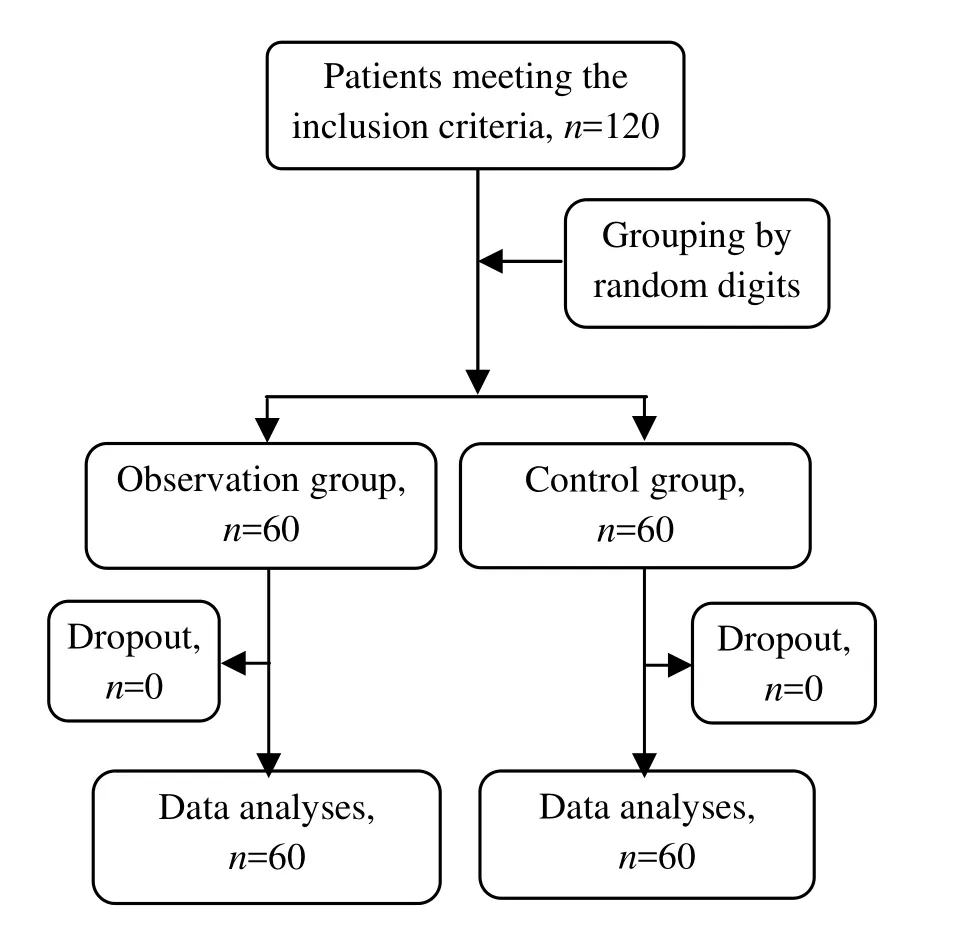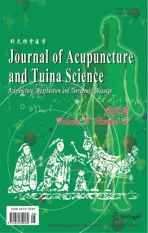Clinical Study on Puncturing Weizhong (BL 40) for Post-stroke Dysfunction of the Lower Limbs
2013-07-18XuJunfeng
Xu Jun-feng
Special Wards of Acupuncture Department, the First Hospital Affiliated to Tianjin University of Traditional Chinese Medicine, Tianjin 300193, China
Clinical Study on Puncturing Weizhong (BL 40) for Post-stroke Dysfunction of the Lower Limbs
Xu Jun-feng
Special Wards of Acupuncture Department, the First Hospital Affiliated to Tianjin University of Traditional Chinese Medicine, Tianjin 300193, China
Objective: To observe the clinical effects in the treatment of post-stroke dysfunction of lower limb by puncturing Weizhong (BL 40).
Methods: One hundred and twenty patients were randomly divided into two groups, 60 cases in each group. Both groups were treated by puncturing Weizhong (BL 40) plus functional rehabilitation training, once every day. Those in the observation group were treated by Shi Xue-min’s needling technique, while others in the control group were treated with routine needling technique. The therapeutic effects were assessed by the scores of lower limb functions of Lovett scale of grading muscle strength (LSGMS) and short-form Fugl-Meyer assessment (SFFMA).
Results: The instant and post-treatment effective rates inthe observation group were 83.3% and 93.3%, versus 6.7% and 53.3% in the control group, indicating that the therapeutic effect was better in the observation group (P<0.01). The instant and post-treatment scores of Lovett muscle strength grading scale were better in the observation group than that in the control group (P<0.05). SFFMA score of lower limbs function was better in the observation group than that in the control group (P<0.05).
Conclusion: Different needling methods at Weizhong (BL 40) can produce different therapeutic effects in treating post-stroke dysfunction of lower limb, and Shi’s needling technique has obvious instant effect and therapeutic function.
Acupuncture Therapy; Stroke; Complications; Point, Weizhong (BL 40); Dyskinesias
The needling technique is one of the factors influencing the acupuncture effect. As early as in 1970s, academician Shi Xue-min carried out quantitative studies on the needling technique and stipulated the quantitative standard of needling technique in the treatment of apoplectic diseases by brain-refreshing and orifice-opening technique and achieved good effect[1-5]. In order to verify the differences in the therapeutic effects of different needling techniques, I carried out the comparative study on acupuncture treatment for post-stroke dysfunction of lower limb by different needling techniques. Now, the report is given as follows.
1 General Materials
1.1 Inclusion criteria
In conformity with the diagnostic criteria of atherosclerotic thrombotic cerebral infarction, stipulated in theKey Diagnostic Points for Cerebro-vascular Diseases[6], Lovett scale of grading muscle strength (LSGMS) was used for assessment of myodynamia[7], below grade IV before treatment, and those with severe complications, conscious and mental disorder and unable to cooperate with the study were excluded.
1.2 General data
All cases were the hospitalized patients with cerebral infarction from the Acupuncture Department of the First Hospital Affiliated to Tianjin University of Traditional Chinese Medicine. By random digits produced by SAS 8.1 software, in accordance with the complete random assignment based upon random digits, totally 120 cases were divided into an observation group and a control group, 60 cases in each group. In comparison of the general data of the two groups, the differences were not statistically significant (P>0.05) and the two groups were comparable (table 1).
The clinical flow of the two groups is shown in Fig.1.
1.3 Statistical methods
The SPSS 11.0 software was used to process the data. Thet-test was used for comparison of the counting data before and after the treatment, and Chi-square test was used for the counting data.P<0.05 indicates a statistical significance.

Table 1. Comparison of general data between the two groups

Fig.1 Clinical flow chart in the two groups
2 Therapeutic Methods
In both groups, the acupuncture needles of 0.30 mm in diameter and 40 mm in length were used to puncture Weizhong (BL 40) on the affected side, but the needling techniques were different.
2.1 Observation group
After the patient took a supine position, the doctor raised up the affected lower limb, with the patient’s knee joint held up by the elbow, and punctured Weizhong (BL 40) by lifting and thrusting technique till the patient’s lower limb twitched for three times, then removed the needle without retaining.
2.2 Control group
After the patient took a prone position, Weizhong (BL 40) was punctured perpendicularly till arrival of the needling sensation, without needling technique. The needle was retained for 20 min.
The patients in the two groups were treated once every day, for four weeks continuously. At the same time, the rehabilitation training of limb was given. The passive training was performed on the sick limb every day, including flexing the knee, raising the knee and rotating the hip. Also, the patients were told to train the activity of various joints of the lower limb. The training was given once respectively in the morning and afternoon, for 15 min each time, continuously for four weeks.
3 Observation of Therapeutic Effects
3.1 Assessment of therapeutic effects
The time point after three sessions was taken as the observing moment to assess the instant effect of puncturing Weizhong (BL 40) for lower limb dysfunctions of the apoplectic patients. LSGMS was taken to assess the changes in the muscle strength of the lower limb before and after treatment. The short-form Fugl-Meyer assessment (SFFMA) scale was taken to assess the functions of the lower limb.
3.2 Criteria of therapeutic effects
Cure: Assessed as grade V by LSGMS.
Remarkable effect: Elevated by two grades by LSGMS.
Improvement: Elevated by one grade by LSGMS.
Failure: No change by LSGMS.
3.3 Therapeutic results
3.3.1 Influence on the grading of lower limb muscle strength
The grading situation observed after three sessions and after the treatment in the patients of the observation group were statistically different (P<0.05), but not statistically different in the control group (P>0.05), indicating that the muscle strength of the lower limb was improved better in the observation group than in the control group (table 2).
3.3.2 Influence on the lower limb dysfunction
After three sessions and after the whole treatment, the differences in the total effective rate between the two groups were statistically significant (P<0.01), indicating that the dysfunction of the lower limb was relieved better in the observation group than in the control group (table 3).

Table 2. Comparison of instant effects in muscle strength grading in the two groups (case)

Table 3. Comparison of instant effects in lower limb dysfunction in the two groups (case)
3.3.3 Comparison of SFFMA scores of lower limb functions in the two groups
SFFMA scores were statistically different after the treatment in patients of the observation group (P<0.05), but not statistically significant in the control group (P>0.05). SFFMA scores were statistically different after the treatment between the two groups (P<0.05), indicating that the lower limb functions were improved better in the observation group than in the control group (table 4).
Table 4. Comparison of SFFMA scores before and after treatment in the two groups (, point)

Table 4. Comparison of SFFMA scores before and after treatment in the two groups (, point)
Note: In comparison of same group before treatment, 1)P<0.05; in comparison of the control group after treatment, 2)P<0.05
GroupsnBefore treatment After treatment Observation 60 10.27±7.31 24.35±8.031)2)Control 60 11.04±8.24 15.21±7.56
4 Discussion
Apoplectic hemiplegia is caused by obstruction of wind and phlegm in the brain and its meridians, leading to stagnation of blood vessel and malnutrition of the tendons. Weizhong (BL 40) is the He-Sea acupoint on the Bladder Meridian of Foot Taiyang. It was recorded in the literature that it can be used to treat hemiplegia. Judging from pathway of the meridian, the Bladder Meridian of Foot Taiyang goes upward directly to the vertex and enters to link with the brain. By strong stimulation to Weizhong (BL 40), it can remove the obstruction in the brain, promote smooth circulation of qi and blood and restore the functions of involved limbs.
This study has proved that puncturing Weizhong (BL 40) by Shi’s needling technique can produce the instant effect in the treatment of apoplectic dysfunction of lower limb, and also the continuous therapeutic effect. Same acupoint punctured by different stimulating method can change the physiological status of Zang-fu organs differently, indicating that better therapeutic effect can only be achieved while reaching certain quantitative standard of puncturing[8-10].

[1] Yang ZX, Bian JL, Xu JF, Shen PF, Xiong J, Guo JK, Zhang JK, Li J, Shi XM. Randomized controlled trial on mind-refreshing and orifice-opening needling method and cerebral infarction. J Acupunct Tuina Sci, 2008, 6(1): 8-12.
[2] Zhang HR, Zhao H. Clinical observations on brain-activating and orifice-opening acupuncture for the treatment of hypertension complicated with stroke. Shanghai Zhenjiu Zazhi, 2012, 31(8): 550-552.
[3] Shi XM. Clinical study on treatment of 9 005 cases of stroke by mind-refreshing and orifice-opening needling method. Zhongyiyao Daobao, 2005, 1: 3-5.
[4] Hu ZC, Wu YC, Wang NH. Clinical study on acupuncture treatment of post-stroke depression in recent ten years. J Acupunct Tuina Sci, 2011, 9(5): 324-330.
[5] Yao PY. Observations on the immediate rehabilitating effect of acupuncture at point Weizhong (BL 40) on lower limb myodynamia in the acute stage of cerebral stroke. Shanghai Zhenjiu Zazhi, 2009, 28(3): 138-139
[6] Chinese Neuroscience Society, Chinese Neurosurgical Society. Key diagnostic points for cerebrovascular diseases. Zhonghua Shenjingke Zazhi, 1996, 29(6): 379-380.
[7] Wang WZ. Neurology. 4th Edition. Beijing: People’s Medical Press, 2002: 40.
[8] Wang YP, Wang CH, Yang HY, Xu JM. Advances in studies on quantification of acupuncture manipulation stimuli. Shanghai Zhenjiu Zazhi, 2006, 25(4): 47-50.
[9] Lin WZ, Wang P. Experimental Acupuncture Science. Shanghai: Shanghai Scientific and Technical Publishers, 1994: 49-75.
[10] Yao PY. Observation on the immediate rehabilitating effect of acupuncture at point Weizhong (BL 40) on the lower limb myodynamia in the acute stage of cerebral stroke. Shanghai Zhenjiu Zazhi, 2009, 28(3): 138-139.
Translator: Huang Guo-qi
R246.6
A
Date: May 8, 2013
Author: Xu Jun-feng, M.D., deputy chief physician.
E-mail: xujunfeng1974@hotmail.com
杂志排行
Journal of Acupuncture and Tuina Science的其它文章
- Efficacy Observation on Acupuncture Combined with Auricular Point Sticking Treatment for Primary Dysmenorrhea
- Immediate Effects of Hegu Needling on Adhesive Scapulohumeral Periarthritis
- Clinical Observation on Acupoint Sticking Therapy for Lumbar Intervertebral Disc Hernination
- Clinical Study on Acupoint Injection for Primary Osteoporosis
- Effect of Electroacupuncture on Anxiety and Craving in Heroin Addicts During Detoxification
- Clinical Observation on Electroacupuncture for Post-stroke Flaccid Paralysis
